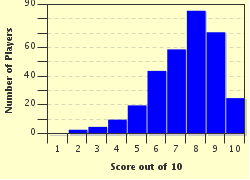Quiz Answer Key and Fun Facts
1. Swan upping is an annual event where swans are counted and marked for ownership. Which of the following swans are counted?
2. Along which river does the annual swan upping take place?
3. During swan upping, if an unmarked swan is found, who owns it?
4. Why was it decided that swan upping should be a necessary annual activity?
5. Some important by-products of the swan can be found during the upping. Which of the following is one of them?
6. How are swans traditionally marked during the swan upping?
7. Death is the penalty for being caught with a swan that belongs to the Lord of the Manor.
8. Approximately when does the annual swan upping take place?
9. Which royal official participates in the annual swan upping?
10. Two companies have been given permission to help with the swan upping. Can you identify one of them?
Source: Author
ponycargirl
This quiz was reviewed by FunTrivia editor
agony before going online.
Any errors found in FunTrivia content are routinely corrected through our feedback system.

